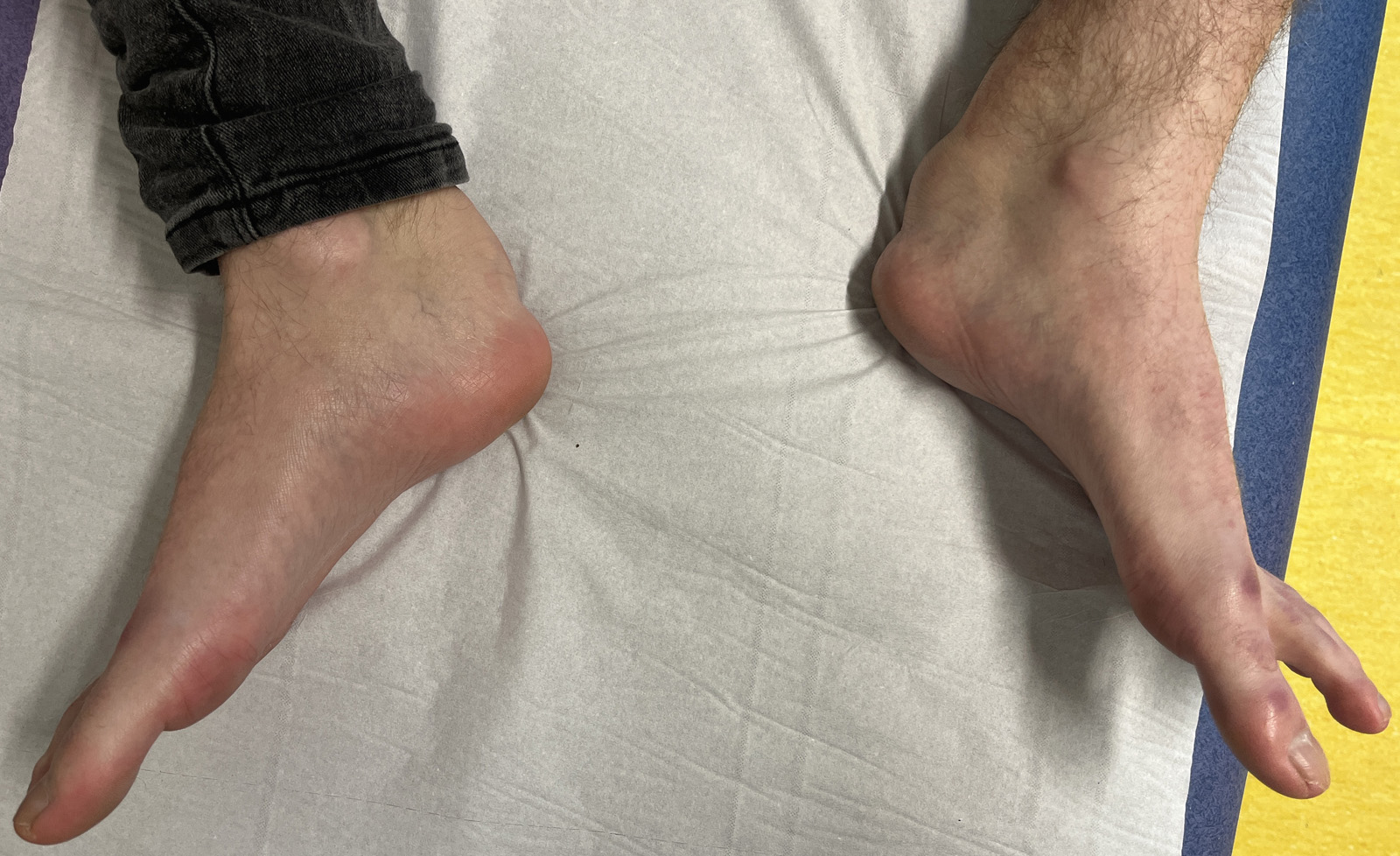Category: Rare Genetic and Metabolic Diseases
Objective: We reported the case of a 24 yo man, adressed to the neurologist by genetician for an unscrambled examination justified by a juvenile cataract at 17. Genetic testing for Steinert and Fabry disease were negative.
Background: The patient had 12 siblings. He related complicated scolarity, and a bad adaptation at work due to ideation slowness. At 20, he underwent a severe depression. Two years after, he had intestinal investigation because of chronic diarrhea, with diagnosis of functional colopathy. He also complained of muscular weakness. The patient was in jail at the time of medical consultation, and came escorted and handcuffed.
Method: Standard neurological examination showed a mild static ataxia, mild pyramidal signs ( right ankle trepidation, brisk lower limb reflexes), mild cinetic cerebellar syndrom, with bilateral postural tremor, without neuroleptic medication.
Physical examination revealed posterior bilateral ankle mass, with a strong suspicion of xanthoma [figure1].
Results: The association of cataract, diarrhea, ataxia and xanthoma, led to cholestanol dosage, which revealed a pathognomonic high rate (65,1 umol/L, ref <10), confirming a cerebrotendinosis xanthomatosis.
Genetic testing of CYP27A1 (ongoing) and brain MRI were performed in a second time (scheduled in april).
Treatment by chenodeocycholic acid was introduced and genetic counselling was proposed.
XCT is rare autosomic recessive disorder of lipids storage (prevalence 1/50 000), classically associating a neonatal cholestasis, an infantile cataract, and later, xanthoma predominantly on ankle or elbows. Few patients had intellectual disability. Neurological signs appeared between 20 and 40 years old, with a progressive cognitive decline, pyramidal signs, ataxia, or less frequently parkinsonism or dystonia.
Conclusion: This diagnosis should be raised for several reasons :
– Although the overall clinical picture is typical, the multisystemic impairment can lead to misdiagnostics.
– There is an effective treatment
– The siblings could be depisted, and treated if concerned.
– As a congenital disease with neurodegenerative process, it should help for reconsidering prior clinical history of the patient, and potentially affect the judicial decision.
– Finally, we remind, if needed, that a neurological examination should always be performed in the best condition to be careful to subtle signs.
Don’t forget to take off socks, even if there is handcuffs !
References: Reference :
– Nóbrega PR, Bernardes AM, Ribeiro RM, Vasconcelos SC, Araújo DABS, Gama VCV, Fussiger H, Santos CF, Dias DA, Pessoa ALS, Pinto WBVR, Saute JAM, de Souza PVS, Braga-Neto P. Cerebrotendinous Xanthomatosis: A practice review of pathophysiology, diagnosis, and treatment. Front Neurol. 2022 Dec 23;13:1049850. doi: 10.3389/fneur.2022.1049850. PMID: 36619921; PMCID: PMC9816572.
– Stelten BML, Dotti MT, Verrips A, Elibol B, Falik-Zaccai TC, Hanman K, Mignarri A, Sithole B, Steiner RD, Verma S, Yahalom G, Zubarioglu T, Mochel F, Federico A. Expert opinion on diagnosing, treating and managing patients with cerebrotendinous xanthomatosis (CTX): a modified Delphi study. Orphanet J Rare Dis. 2021 Aug 6;16(1):353. doi: 10.1186/s13023-021-01980-5. PMID: 34362411; PMCID: PMC8349076.
– Freedman SF, Brennand C, Chiang J, DeBarber A, Del Monte MA, Duell PB, Fiorito J, Marshall R. Prevalence of Cerebrotendinous Xanthomatosis Among Patients Diagnosed With Acquired Juvenile-Onset Idiopathic Bilateral Cataracts. JAMA Ophthalmol. 2019 Nov 1;137(11):1312-1316. doi: 10.1001/jamaophthalmol.2019.3639. PMID: 31536098; PMCID: PMC6753501.
– Nie S, Chen G, Cao X, Zhang Y. Cerebrotendinous xanthomatosis: a comprehensive review of pathogenesis, clinical manifestations, diagnosis, and management. Orphanet J Rare Dis. 2014 Nov 26;9:179. doi: 10.1186/s13023-014-0179-4. PMID: 25424010; PMCID: PMC4264335.
To cite this abstract in AMA style:
A. Riou, L. Pasquier. From foot to head: look after your socks ! [abstract]. Mov Disord. 2023; 38 (suppl 1). https://www.mdsabstracts.org/abstract/from-foot-to-head-look-after-your-socks/. Accessed April 20, 2025.« Back to 2023 International Congress
MDS Abstracts - https://www.mdsabstracts.org/abstract/from-foot-to-head-look-after-your-socks/

